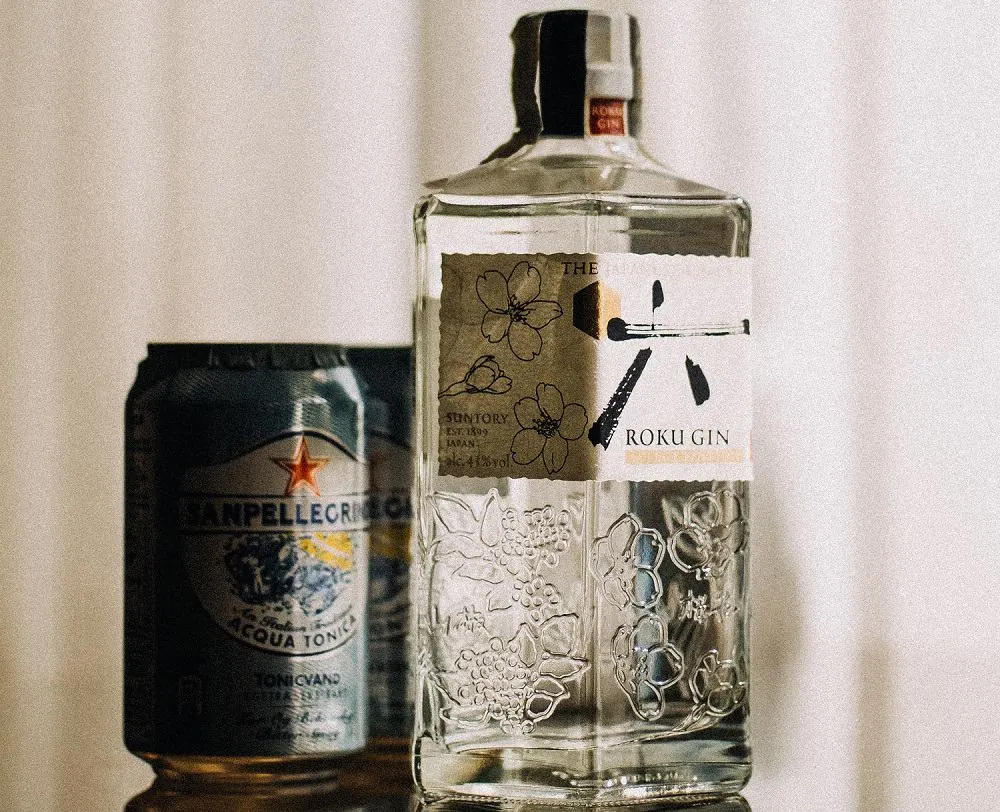The word “Roku” in Japanese translates to the number six. This is due to the fact that every bottle of Roku Gin is made from exactly six botanical ingredients that are sourced in Japan.
The Japaneses are known the world over for their attention to detail and meticulous craftsmanship. This reputation is well deserved and is evident in many Japanese products. Roku Gin is no different.
Roku Gin first appeared in 2017 and is classified as a London Dry Gin. It typically comes in 750ml bottles and is 86 Proof.
In this review, we’ll be taking a look at Roku Gin, from the history of the drink, to its ingredients, and flavor profile.
A Brief History Of Roku Gin
Roku Gin is distilled and distributed by Suntory Holdings Ltd. Suntory is headquartered in Osaka, Japan and is one of the oldest brewing and distribution companies in Japan. The legacy of the Suntory brand dates back to 1899, with it predecessor, The Torii Shoten Store.
The Torii Shoten Store was opened by Shinjiro Torii, who wanted to make original Japanese spirits that can be enjoyed throughout the world.
After successfully making his dream a reality, creating whiskey, wine, and brandy, Shinjiro launched the first Suntory Gin in 1936 called Hermes Gin. Roku Gin is the product of over 100 years of expertise and is the result of the hard work and dedication of Shinjiro and his successors.
The Six Botanical Ingredients Of Roku Gin
As mentioned before, Roku Gin (see also: Monday Gin Review)consists of six botanical ingredients. These six botanical ingredients are harvested throughout the year, when each of them is at its peak of season.
The thinking behind this is that Roku Gin encapsulates the seasons and spirit of Japan, the six botanical ingredients are divided into the four seasons, Spring, Summer, Autumn, and Winter.
These ingredients are:
Sakura Flower
Sakura Leaf
Sencha Tea
Gyokuro Tea
Sansho Pepper
Yuzu Peel
The thinking behind each of these ingredients is that when they’re blended together, they take the consumer on an authentic journey through the four distinct Japanese seasons. Each of these ingredients are uniquely Japanese, and as such are best understood by Japanese artisans.
Suntory created their own multiple distillation process due to the special features of each botanical.
Alongside these distinct botanicals, Roku Gin comprises eight traditional gin ingredients such as Juniper berries, cardamon, bitter orange peel, and lemon peel.
Whilst the main six ingredients make up the main flavor profile, the addition of the eight traditional botanicals brings the total to fourteen essential components. This gin is distilled from a general neutral base of grain.
In terms of craftsmanship, Roku Gin is produced in a specialized craft distillery – “Liquor Atelier.” The Atelier has four unique types of pot stills and each of the botanicals are distilled separately – a process which is unique to Roku.
For example, the cherry blossom is drawn out via vacuum distillation in stainless pot stills, whereas the flavor of yuzu is achieved through distillation in copper pot stills.
Roku Gin Bottle Design

The thoughtfulness and absolute attention to detail that goes into every bottle of Roku Gin makes you feel like you’re buying a tiny piece of Japanese culture. Whilst what’s in the bottle is the main point of this review, it’s worth mentioning that the bottle itself could be considered a work of art.
The bottle’s design contributes to the aesthetics of this quintessentially Japanese drink in that from the top to the bottom of the bottle, every aspect has been carefully considered. The bottle has exactly six sides.
This is directly related to the six ingredients cultivated in Japan, as each of the sides has images of these ingredients embossed on the glass. The bottle’s label is made of a traditional rice paper known as washi paper.
Tasting Notes Of Roku Gin
Roku Gin has top notes of cherry blossom thanks to the Sakura flower and Sakura leaf. There are notes of green tea citron and pepper which emerge briefly, its delicate aroma quickly passes dissipates on the nose.
It has a rich character as it hits the tongue. Starting from the moment it touches the lips, there’s a short glimpse of the cherry blossom and the traditional gin notes from the aroma. The tannic and tea notes then take over, followed by a heavy, leafy green and Earl Grey tea flavor.
There’s something to be said for the bitter citrus notes and smokey leaves that follow. The bitterness is quite striking and resembles something like Suze. This bitter note evokes a gentian root and wormwood finish.
The palate on the Roku Gin could be considered clinical in terms of the developing flavor and mouthfeel. We found that there are a few surprises with the taste, it’s a gin that’s slightly unusual.
Roku Gin And Cocktails
No products found.
We felt that this gin’s strikingly bitter flavor profile would make it a challenge to mix. Traditional serves like tonic came off as unusual and didn’t quite sit right with us, it was less refreshing than you might expect.
That being said, Roku served at room temperature over ice with tonic and some slices of ginger could work.
We’d argue that whilst it’s not suitable for traditional serves, sipping Roku neat is very enjoyable.
It’s not really suitable for use in something like a Ramos Gin Fizz, as it’s too robust. In fact, it most likely isn’t suitable for any dessert style gin cocktail.
That being said, Roku is at home when mixed in a Martini. Its bitterness is a prerequisite for the inclusion of Vermouth in the classic Martini. Even if you prefer a super dry Martini, the inclusion of Roku Gin doesn’t downplay the expected notes.
It also works very well in the classic Italian cocktail Negroni, the addition of Roku Gin actually complimented the Campari and red vermouth.
Pros And Cons Of Roku Gin
Whilst these pros and cons could be considered subjective and down to personal preference, we felt that some main points could be summarized and are consistent with other people’s experiences with Roku Gin.
Pros
- A very complex and subtle gin
- It’s generally affordable when considering how well-made it is
- Owing to the complexity of Roku Gin, it should be perfect for branching out into new cocktail territory
Cons
- This Gin isn’t suitable for your average Gin and Tonic drinker
- Short on the finish
How To Spot Fake Roku Gin
There are usually a number of ways to tell if you’re buying fake Roku Gin. One lesser known way to tell is that some fakers of Roku Gin overfill the bottle. This isn’t always the case, so it can be hard to spot. The best way to tell is the price you pay for a bottle.
Roku Gin typically retails around the $28 to $35 mark, anything less than that, and you’re most likely buying fake Roku.
Final Thoughts
Roku Gin has a lot of things going for it. It’s a truly unique liquor, not just in terms of the delicate and complex flavor but also in the overall aesthetic and presentation.
Throughout the entire process of making this gin, each step has been carefully considered. From the ingredients which make up the composition, to their distilling process, right through to the design of the bottle.
This methodical process, along with the finished product, is what makes Roku Gin definitively Japanese.
Roku Gin isn’t really a Gin and Tonic gin and should be treated as such. It could be worth trying in a Gin-Gin Mule, but in reality it’s delicious neat over ice.
Any fans of complex botanical gins should give a bottle of Roku Gin some serious consideration. For those of us who are attempting to break new cocktail ground, Roku Gin might just be an excellent and intriguing addition to a cocktail.
Roku Gin is available from selected retail outlets, including:
